Enjoy Busan
The top places to see plum blossoms in Busan
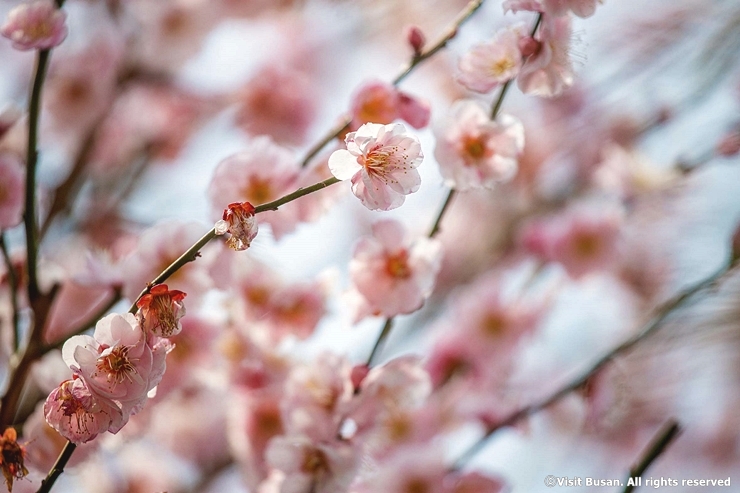
Blooming flowers herald the arrival of spring. In Korea, spring is commonly associated with forsythias, azaleas, canola flowers and cherry blossoms.
However, the plum blossom, called "maehwa" in Korean, is the first flower to bloom when spring arrives on the peninsula. Thanks to its southern location, Busan greets spring flowers earlier than other parts of the country.
In this issue, Busan is Good recommends the best locations citywide where you can enjoy the beautiful palette and wonderful fragrance of plum blossoms.
Maehwa
In Korean culture, the "Sagunja," or "Four Gracious Plants," refers to the orchid, chrysanthemum, bamboo and plum blossom. Each plant represents virtuous traits one should possess to be a noble person and leader.
As one of the Sagunja, plum blossoms symbolize resilience and perseverance in the face of adversity because it is the first flower to bloom after enduring harsh winter weather. These traits are highly respected in Korean society, which gives the plum blossom a significant status among Korean symbols.
Plum blossoms feature red, white or pink petals. The pink flowers are commonly confused with cherry blossoms. However, it is easy to distinguish the two plants by their petals. Cherry blossom petals have a small slit at the end, while plum blossoms do not.
Busan plum flower hot spots
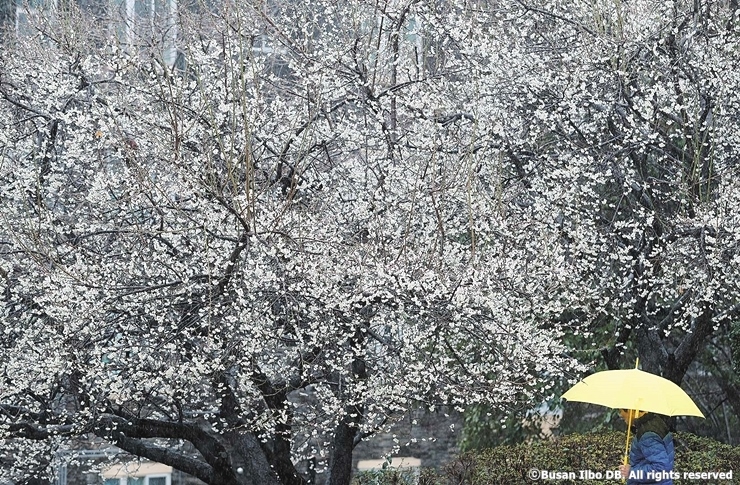
Plum blossoms are a colorful antidote to springtime's gray, rainy days.
■ Suyeong Historical Park
The first place to check out plum blossoms is Suyeong Historical Park, where plum trees stand guard among ancient military structures. The trees will bear flower buds in early February; plum flower blossoms come into full bloom by late February and early March.
During the Joseon Period (1392 to 1897), the Suyeong area housed the Headquarters of Gyeongsangjwado Naval Force Command, a military post vital to defending the peninsula's southern border. The Suyeong Historical Park features traces of the command, such as the South Gate of the Suyeongseong Fortress.
• Address: 43 Suyeongseong-ro, Suyeong-gu
• Hours: Open 24 hours
• Admission: Free
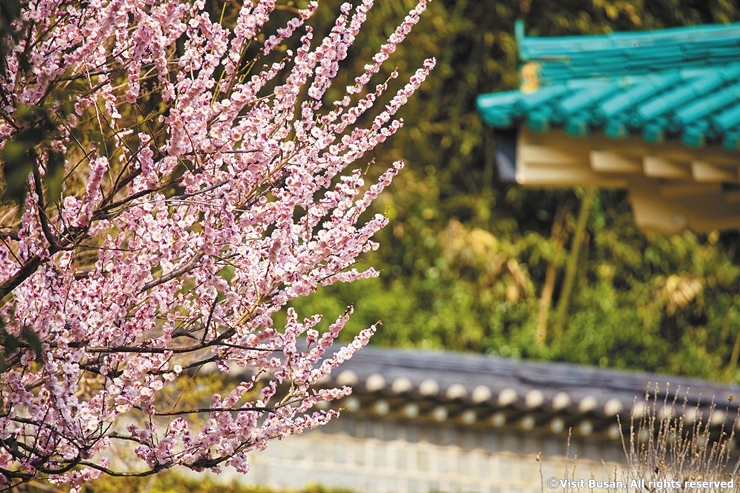
The atmosphere at Chungnyeolsa Shrine is brightened by the yearly emergence of plum blossoms.
■ Chungnyeolsa Shrine
Chungnyeolsa Shrine, which is designated as tangible cultural property No. 7, holds the ancestral tablets of patriotic martyrs who sacrificed themselves during the Japanese Invasions of Korea in 1592. Visitors to the shrine may encounter unexpected joy thanks to the flowers on display. Despite its heavy atmosphere, Chungnyeolsa is also known as one of the best flower-viewing spots throughout the year, often visited by residents and tourists across the country.
Red and white plum blossoms welcome visitors just past the main entrance. The trees are so tall and thick that the flowers growing out of their branches look like heaps of white snow. Other spring flowers, such as yellow cornus officinalis, white magnolia kobus and red camellia, also fill the area.
• Address: 345 Chungnyeol-daero, Dongnae-gu
• Hours: Open 9 a.m. to 8 p.m. Main Hall and Memorial Hall close at 6 p.m.
• Admission: Free
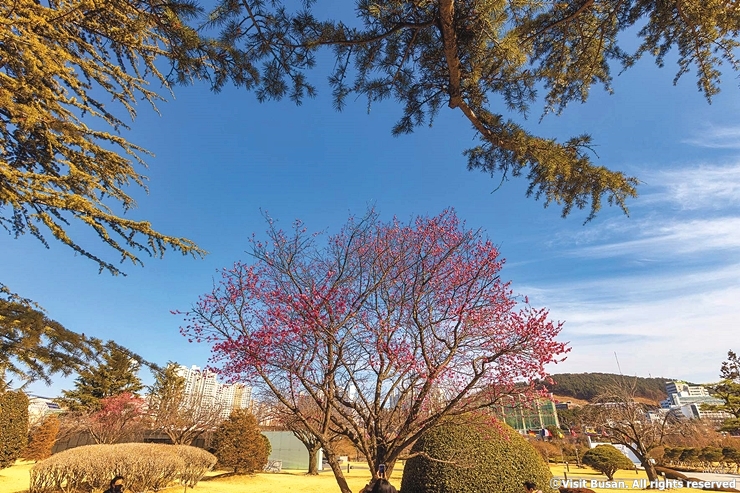
The deep red plum blossoms at UNMCK are a reminder of the sacrifices made to protect Korea.
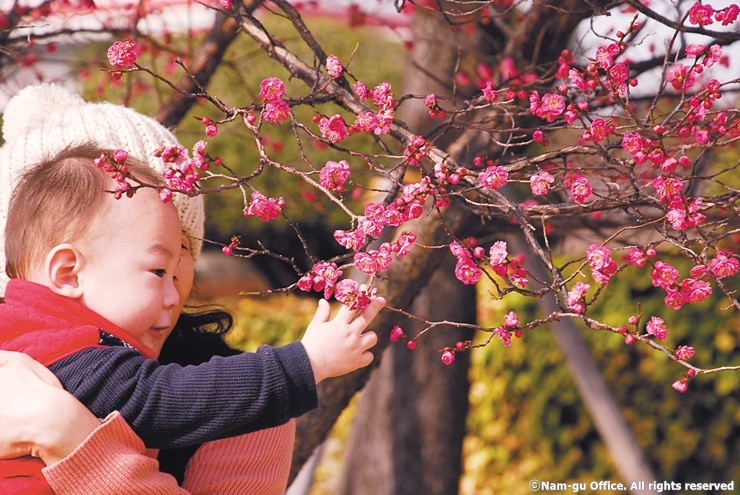
This child has a bright future thanks to the soldiers lying in rest at the UNMCK.
■ U.N. Memorial Cemetery
The United Nations Memorial Cemetery in Korea, the only U.N. cemetery in the world, is the final resting place for fallen soldiers who fought for democracy during the Korean War in the 1950s. Over 2,300 brave souls are interred at the cemetery, having come to fight for Korea from countries such as the U.K., Turkiye, Canada, Australia and the Netherlands.
The serene park spreads across a grassy area of 135,000 square meters. Some notable sites and memorials include the Memorial Service Hall, Symbolic Area, Wall of Remembrance, U.N. Forces Memorial and Main Grave Area.
Most of the time, the park is peaceful and quiet, but crowds of visitors come to view plum flower blossoms at this time of the year. Among the numerous flower spots in Busan, the U.N. Memorial Cemetery is particularly popular because of its collection of red plum flowers, which are prized for their beautifully colored petals and captivating fragrance. People cannot help but notice the red plum blossoms, even from a distance.
Visitors are not allowed to make noise or exercise while in the park. Also, the following attire is considered inappropriate for entering the cemetery: Athletic wear, overly revealing clothes and slippers.
• Address: 93 UN Pyeonghwa-ro, Nam-gu
• Hours: Open 9 a.m. to 5 p.m. from April to October. Open until 6 p.m. from May to September.
• Admission: Free
• Website: unmck.or.kr
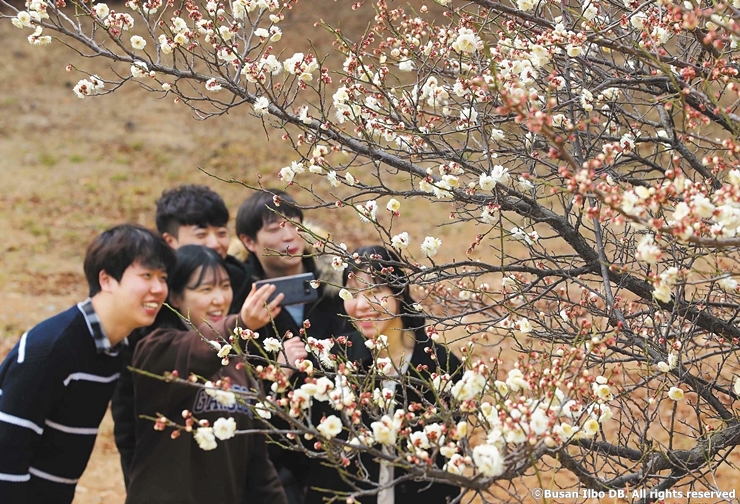
Students at Tongmyong University take a break from studying to admire the plum blossoms that adorn the campus.
■ University Campuses
Gardens in the university campuses across the city are full of spring flowers. In March, fully-bloomed plum blossoms welcome freshmen and congratulate them on a new beginning. You can visit Busan National University or Tongmyong University to experience the fresh spring scent.
• Busan National University: 2 Busandaehak-ro 63beon-gil, Geumjeong-gu
• Tongmyong University: 428 Seinseon-ro, Nam-gu
■ What about other spring flowers?
Cherry blossoms: Cherry blossoms are a welcome sight throughout the country, with their beautiful pink petals sparkling in the warm sunlight. Late March to mid-April is the peak of cherry blossom blooms in Korea.
• Where to go: Nakdonggang Riverside Road in Sasang-gu and Oncheoncheon Steam across Geumjeong-gu and Yeonje-gu.
Canola flowers: A wave of bright yellow petals and green stems in canola flower fields help people indulge in a sea of spring. Canola flowers are at their peak in March and April.
• Where to go: Daejeo Eco Park and Samnak Eco Park in Gangseo-gu, Oryukdo Sunrise Park in Nam-gu and Busan Citizens Park in Busanjin-gu.
Azaleas: You can find beautiful pink azaleas on mountainsides and hillside forests. They start to bloom at the end of March in Korea. Mountainsides covered in blossoming azaleas are a feast for the eyes.
• Where to go: Hwangnyeongsan Mountain and Baesan Mountain in Yeonje-gu and Sosanmaeul Village in Gijang-gun.
Forsythia: Sturdy forsythia flowers bloom everywhere around the city, in parks, by rivers or along roads. Their bright yellow petals signal a new beginning for Busanites, as they are in peak bloom at the start of a new school year.
• Where to go: Dalmaji Hill in Haeundae-gu and Galmaet-gil Trails in Myeongji Ocean City in Gangseo-gu.
<Voca Spotlight>
herald: 전령(n), 알리다(v)
forsythia: 개나리
azalea: 진달래
canola flower: 유채꽃
cherry blossom: 벚꽃
plum blossom: 매화 (*plum: 매실)
peninsula: 반도
orchid: 난초
chrysanthemum: 국화꽃
bamboo: 대나무
resilience: 복원력, 회복력
perseverance: 인내력, 끈기
adversity: 역경
harsh: 가혹한
petal: 꽃잎
ancient: 고대의
Shrine: 사당
tangible: 유형의, 형태가 있는 (*tangible cultural property: 유형문화재)
cornus officinalis: 산수유
magnolia: 목련
camellia: 동백
serene: 고요한
numerous: 수많은
captivating: 매혹적인
attire: 복장, 옷차림
stems: 줄기

